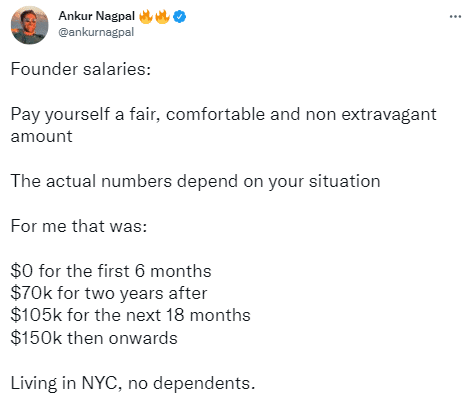Business expenses can pile up quickly if you don’t have a sound budgeting strategy.
Running a company without a well-thought-out budget could get you into some financial trouble.
In 2020, 35% of businesses spent more than they planned. Without good backup and extra cash, these businesses could have gone bankrupt.
What’s even sadder is that 46% of companies didn’t even create a budget for 2021.
If you don’t want to face the same dangers, read on to find out how to become a pro at budgeting and save yourself from a lot of financial headaches!
- Create Your Business Plan First
- List the Potential Risks to Your Budget
- Choose the Right Budgeting Method
- Set Realistic Budget Expectations
- Leave Room for Unpredictable Costs
- Include Your Salary, Too
- Conclusion
Create Your Business Plan First
Your business plan is the starting point of your budget.
Generally, a business plan should cover a longer timespan and incorporate your long-term goals, marketing, and strategy.
You should start creating a plan by identifying small, attainable objectives for the organization that lead to achieving the greater goals you’re working towards.

Source: RegPack
Budgeting is just a fraction of the yearly business plan, even though vital. After all, you have to manage your funds and decide how to spend them to achieve those smaller goals.
That kind of company plan will keep you on track.
Check it frequently and see whether you’re doing more than you originally planned. If so, you might overstep your budget and get into financial problems.
An excellent business strategy will also function as a guide to what you’re trying to accomplish.
When you come up with new ideas and try to fit them into your budget, use the plan to see how the ideas fit into your overall yearly plan.
When unsure where to begin with your business strategy, start with the big picture and work your way down. FNBO suggests kicking off with an overview of what you want to achieve.
They also provide a sample of how this section of your business plan should look.

Source: FNBO
Give some background on your company’s beginnings and how it came to be before moving on to the goals and objectives.
Why did you establish your company? These targets will assist you in determining the specifics of your strategy.
When you list these things, go on to explain:
- your products or services
- your pricelist
- market research results
- marketing and sales efforts
- daily operations
- budget
- summary
Going into the nitty-gritty of all these points will take time, but it will make an excellent reference point for future decisions, particularly financial ones.
List the Potential Risks to Your Budget
A business budget is your financial statement for the upcoming year.
At the end of every year, you should put your budget down on paper, allocating the available funds amongst various business operations and commitments.
However, you shouldn’t overlook potential budgeting risks.
Such risks are defined as “the potential for certain items to deviate from the originally predicted cost,” which means you should pay close attention to every aspect of your budget and figure out which items could end up costing you more.
“Understanding the potential risks facing you on a short- and long-term basis is important for all small businesses,” FinTech executive Paul Cho said for Business News Daily.

Source: RegPack
Cho is right: these risks will help you plan and budget better, so understanding them is simply essential.
Some of the factors Cho discusses, such as changes in the minimum wage, healthcare requirements, or natural disasters, are ideal places to start when assessing risk.
All of these changes could substantially impact your budget and business operations, which is why you should plan.
Surprisingly, despite how contradictory it may seem, rapid growth is one of these things.
Let’s assume you aim to sell 1,000 products per month and have the materials to fulfill those orders.
However, if your business suddenly expands and you need to fulfill orders for 2,000 items, you’ll have to make adjustments.
Some of them, such as ordering more materials, may be costly.
If you place an order last minute, you’ll pay more than usual, just like you will for express shipping.
As a result, you may spend more due to the sudden doubling of orders than you would for sustained, natural growth.
Allowing risks to catch you off guard might lead to bankruptcy, so keep track of all financial dangers you might face.
Choose the Right Budgeting Method
There is no one-size-fits-all approach to budgeting, but a suitable budgeting method for your company does exist. It’s simply up to you to find it.
The expense management solution Divvy claims that companies tend to use one of the following five budgeting methods:
- Incremental
- Activity-based
- Zero-based
- Value proposition
- Flexible
The incremental approach lets you use last year’s budget and add or subtract an increment or percentage to it based on how accurate your predictions previous year were.
If you overestimated the expenses last year, you could deduct a portion from the new year’s budget.

Source: Divvy
Likewise, if you’ve underestimated them, you can expand the budget with an increment you see fit.
To understand your budget, use last year’s spending as this year’s budget starting point, and see how accurate it was.
The activity-based method includes identifying business activities for the next year, their units, and how much each unit will cost.

Source: Divvy
You can use this formula:
Overhead cost per activity X Number of activities = Assigned funds
If you think you’ll sell 1,000 products that cost $2 to produce, you’ll assign $2,000 for unit production. This technique helps you understand how you spend each dollar.
With the zero-based approach, each department starts with a budget of $0. Then, the departments make budget predictions and justify them.
The zero-based method is something of a a time-consuming process, however, this technique lets you allocate funds to the teams that need them.

Source: Divvy
Every fiscal year, you can change your budget predictions completely. Let’s say your marketing team got $10,000 last year.
Since they plan to expand their activities and hire more people, the team will ask for a higher budget, and you can approve it if you think the demand is justified.
Combining incremental and zero-based approaches gives you the value proposition budgeting method.
Through this approach, businesses compare past spending with their goals to cut unnecessary costs.
First, you have to determine your business goals or visions, which you do in your business plan.
Then, identify the programs and activities that help you achieve those goals. Finally, you’ll distribute your funds between these activities by deciding which goal takes priority.
The flexible budgeting method allows you to switch things up monthly. This option is best for businesses that sell products or services seasonally.
If you sell skiing equipment, you’ll allocate more funds to the winter months and less to summer ones because that’s when you expect the least production and sales.

Source: Divvy
The flexible approach will work for you if your income varies from month to month.
When it comes to budgeting methods, you have several options.
The right budgeting technique for your business should be compatible with your risks, strategies, and financial expectations.
Set Realistic Budget Expectations
Starting with reasonable financial expectations is the best way to create a budget.
If you don’t want to constantly go over budget, make decisions based on data you can trust.
When making a budget for this year, be realistic rather than wishing for the best. How much money will you be able to spend on your business over the year?
Once you have a basic idea of that figure, use your budgeting approach to determine how much you’ll spend on each activity or section.
The more specific you are, the less room for error you leave.
If you’ve been in the business for a while, you can use your last year’s expenses statements to create a budget for next year, considering exactly how much you spent on which part of your business plan.
With software like Regpack, you’ll have the option to generate reports and use actual data to determine how much you earned last year.

Source: RegPack
Furthermore, you’ll be able to monitor how many customers pay on time and how many are late, which will help you with budget forecasting.
Consider your expected revenue in addition to the previous year’s predicted and actual budget.
Don’t be overconfident and hope to repeat last year’s best-selling month every month. Instead, aim for the median to ensure you don’t overestimate your resources.
Also, consider possible changes to your operations.
This factor could include hiring more employees, expanding your production, inflation, and anything else that you already know will impact your bottom line.
You won’t get caught off guard if you factor these possible changes into your budget.
When creating your budget, use real data to calculate what you can spend while staying realistic.
Leave Room for Unpredictable Costs
Unpredictable costs are every budget’s worst enemy. As the name implies, these are expenses that you cannot forecast, which leaves you vulnerable.
While you can’t predict which problem will arise or how much money you’ll need to fix it, you can plan for the unexpected by setting money aside.
Because this scenario is the biggest financial difficulty for 11% of organizations, it’s important to factor it into your budget.

Source: Regpack
Business News Daily also reports that Doug Keller, a financial planner at Peak Personal Finance, recommends businesses overestimate costs to prepare for the unexpected.
Keller says that “failing to anticipate an expense or its magnitude could prove disastrous and cripple the organization before it has had time to grow,” which is why you have to predict as many possible costs as you can.
Constellation and US Chamber list some of the most common costs businesses fail to predict, such as:
- Location and energy costs
- Employee costs
- Maintenance and repairs
- Software fees
Experts agree that you should calculate next year’s budget and then include a further 20% to cover these unexpected charges.
Some of these costs, such as location and labor costs, are undoubtedly related to unexpected growth.
Suppose your business suddenly receives a rush of orders. In that case, you’ll need to invest in more materials, personnel to fill orders, and staff to answer customer inquiries, all of which incur costs.
Similarly, the more you use your business machinery, vehicles, and equipment, the more likely it will break down or require maintenance.
As a result, you should always budget for failures and repairs.
Furthermore, if you neglect to incorporate software fees in your yearly projections, you risk exceeding your budget.
Most software firms want you to pay monthly or annually, and the expenses can add up quickly if you need more accounts.
It would be wise to use apps that can automate multiple tasks. That way, you won’t have to pay ten different organizations for something a single tech tool can do.
For example, Regpack automates your billing process and supports recurring billing while also offering reporting tools that help you determine your next year’s budget.
These features will benefit anyone who wants to get paid on time and have an overview of their expenses and outstanding balances.
Leaving room for unpredictable costs will help you stay afloat if you run into unexpected problems.
Include Your Salary, Too
If you want to be great at budgeting, never forget to pay yourself.
In fact, some experts advise you to pay yourself first! As an entrepreneur, you are, after all, your own employer, and you operate the company.
Your finances will suffer if you continue to put your paycheck on hold to pay everyone and everything else. Unfortunately, many business owners fail to realize this.
When talking about this common phenomenon, Keller said that “some people feel guilty paying themselves when it seems the money could be allocated elsewhere … but at the end of the day, the owner is still just an employee.”
Remember these words when considering your salary, and compensate yourself fairly for the amount of labor you put in.
You might have an issue determining how much you can pay yourself. If that’s the case, start by looking at your revenue and profit margins.
How much money do you have left after you pay your team and settle all your outstanding balances?
This figure may fluctuate year to year, depending on how well your company performs.
Teachable’s founder, Ankur Nagpal, described how giving himself a salary worked when he started his business.

Source: Twitter
Nagpal didn’t earn a dime from his business in the first six months, but in less than two years, he worked his way up to $150,000.
When you can pay yourself extra for the work you accomplish, take advantage of it.
However, don’t overpay yourself, either. The IRS warns company owners of this, stating that “wages paid to you as an officer of a corporation should generally be commensurate with your duties.”
If your pay is significantly higher than that of others performing similar tasks, the IRS may investigate the company’s finances.
In conclusion, it’s critical that the income you pay yourself matches your work, so don’t pay yourself too little or too much, and stick to your budget!
Conclusion
Budgeting does not have to be difficult, even if you are just starting a business and have no idea where to begin.
You have to write a long-term company plan that outlines your yearly objectives. Then, create a budget that helps you achieve those goals.
Set aside more money for the initiatives that can help you achieve your business plans.
So, choose the best budgeting strategy for your company and be realistic with your projections.
Being aware of the potential for unexpected expenses is also a good starting point.
Finally, don’t feel bad about giving yourself a fair wage—you’ve worked hard for it!


















